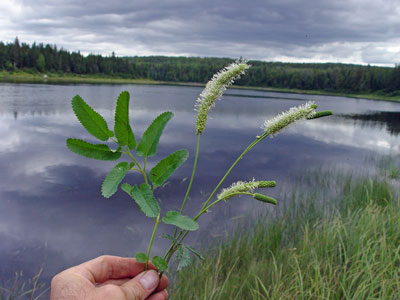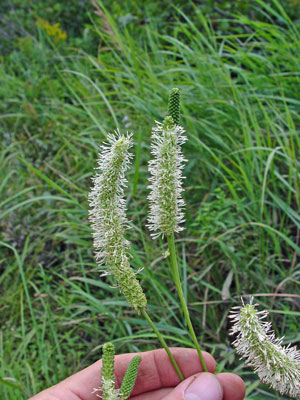DACF Home → Bureaus & Programs → Maine Natural Areas Program → Communities, Plants, and Animals → Rare Plants → Sanguisorba canadensis

Sanguisorba canadensis L.
Canada Burnet
- State Rank: S1
- Global Rank: G5
- State Status: Threatened
Habitat: Peaty or boggy soils. [Conifer forest (forest, upland); Non-tidal rivershore (non-forested, seasonally wet)]
Range: Newfoundland and Labrador to Manitoba, south to New Jersey, Pennsylvania, Ohio, and Indiana.
Aids to Identification: Canada burnet is a perennial herb which arises from a thick rhizome. It has alternate, pinnately compound leaves, with 7-15 sharply toothed leaflets. Its small white flowers are clustered in a dense spike, 3-12 cm long. The flowers have 4 petal-like sepals, which are only 2-3 mm long, and each flower has 4 stamens that are much longer than the sepals. The similar S. officinalis has purple sepals and is a cultivated species that would not be found in similar habitats.

Ecological characteristics: Grows in areas kept free of dense trees or shrubs by natural or human disturbance. The populations known along northern rivershores are typically very small.
Phenology: Flowers July - September.
Family: Rosaceae
Synonyms: None noted.
Known Distribution in Maine: This rare plant has been documented from a total of 8 town(s) in the following county(ies): Aroostook, Hancock, Oxford, Somerset.
Reason(s) for rarity: Disjunct from principal range.
Conservation considerations: Naturally occurring populations along rivershores are maintained by hydrologic disturbance. One population along a woods road is maintained by infrequent grading.